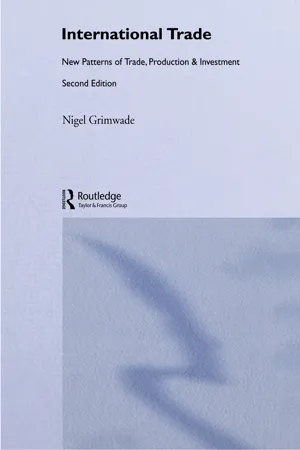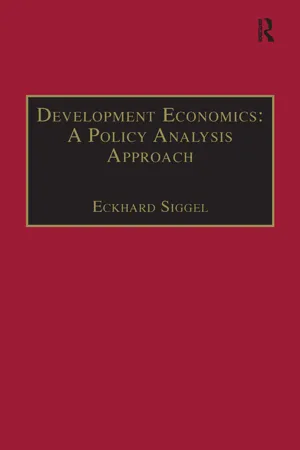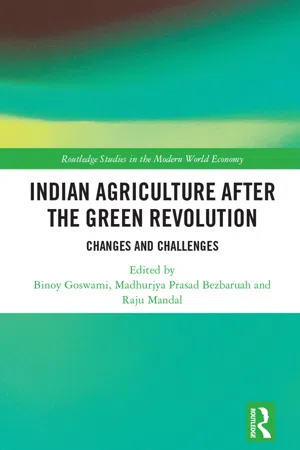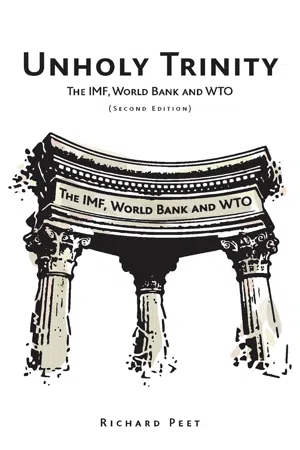Economics
Trade Liberalization
Trade liberalization refers to the removal or reduction of barriers to international trade, such as tariffs, quotas, and other restrictions. The aim is to increase the flow of goods and services between countries, leading to greater economic efficiency, competition, and consumer choice. Proponents argue that it can stimulate economic growth, while critics raise concerns about its potential impact on domestic industries and employment.
Written by Perlego with AI-assistance
Related key terms
9 Key excerpts on "Trade Liberalization"
- eBook - ePub
Globalization
North-South Perspectives
- John Glenn(Author)
- 2012(Publication Date)
- Routledge(Publisher)
The final stage had the objective of promoting export-led growth by: liberalizing trade (reduction of tariffs); eliminating non-tariff barriers to trade; removal of restrictions on finance and investment from abroad thereby providing an investor-friendly environment for those seeking a low-cost base from which to produce and export. 9 Why promote such policies? Underpinning such reform attempts is the belief that increases in trade promote growth, which in turn is said to lead to a reduction in poverty. The arguments for greater Trade Liberalization are usually based on Ricardo’s principle of comparative advantage: trade between countries leads to each country specializing in the industries that are relatively more efficient. However, as Joseph Stiglitz and Andrew Charlton point out, this argument for free trade is based upon a more efficient allocation of resources rather than upon growth per se, although of course the end result of comparative advantage should be an increase in overall output for all parties involved. In addition, trade is said to promote growth in a variety of ways. First, integration into the world trade system provides export opportunities for domestic firms; larger markets imply that companies will thus benefit from increases in economies of scale thereby increasing returns on their initial investment. Second, a country benefits greatly if innovations are disseminated rapidly throughout a given industry bringing increased efficiency and a competitive edge against rivals. Trade Liberalization should lead to more rapid and wider dissemination of technical know-how, but in addition the specialization that is said to follow from Trade Liberalization also leads to a more rapid ‘spillover’ from one firm to another - eBook - ePub
Trade Facilitation in the Multilateral Trading System
Genesis, Course and Accord
- Hao Wu(Author)
- 2018(Publication Date)
- Routledge(Publisher)
Anti-globalization campaigners are vocal in their criticism that globalization concurrently has caused negative side-effects, such as inequality, marginalization of small and vulnerable economies, shrinkage of traditional industries and damage to the environment. While some may contend that ‘it is the best of times’, it could also be ‘the worst of times’ 1 in the eyes of others. Nevertheless, ‘[t]oday globalization is fact of life, so the question is less about whether or not we like globalization – it is more about how we should respond’. 2 At the dawn of the new millennium, world leaders declared that ‘the central challenge we face today is to ensure that globalization becomes a positive force for all the world’s people’. 3 As Margaret Thatcher conveyed, ‘there is no alternative’. The calls for free trade Free trade (also known as ‘Trade Liberalization’) is the enduring and dynamic engine that has driven globalization forward. 4 Liberalizing trade entails eliminating restrictions and barriers on the exchange of goods and services between countries. Among the restrictions and barriers, tariffs and non-tariff measures (NTMs) are the most salient. In the modern world where countries are tightly connected by international trade, if we are committed to steering globalization towards a promising trajectory, we should accelerate the momentum of free trade. At least, what generations of theorists have advocated is still worth heeding. The notion of free trade can be traced back to the Grotian tradition. Hugo Grotius, in The Free Sea (1609), articulated the rule of international law as the foundation: ‘it is lawful for any nation to go to any other and to trade with it’. 5 On free trade, he wrote in Commentary on the Law of Prize and Booty (1605): Freedom of trade, then, springs from the primary law of nations, which has a natural and permanent cause, so that it cannot be abrogated - eBook - ePub
- Peter Drysdale, Ligang Song(Authors)
- 2003(Publication Date)
- Routledge(Publisher)
Statistical Yearbook of China , 1998.TRADE REFORM
A key to understanding the rapid expansion of foreign trade in China is policy reform and trade liberalisation within a broad program for economic restructuring. Trade liberalisation, according to Greenaway and Sapsford (1994: 158), can be defined as a process involving three elements: a reduction in import barriers with no change in export incentives; a movement of relative prices towards neutrality via a reduction in import barriers and/or an improvement in export incentives; and the substitution of less costly instruments for more costly instruments of protection, for example tariffs or quotas. China has made progress in all three areas, as documented in Harding (1987), Hsu (1989), Wang (1993), Lardy (1992), Zhang (1993) and Li (1997).As regards the link between trade liberalisation and trade expansion, several multi-country studies, for example Harrigan and Mosley (1991) and Papageorgiou, Michaely and Choksi (1992), offer support for the view that liberalisation and exports are related. The main proposition behind these studies is that liberalisation reduces anti-export bias and thus provides a conducive setting for export expansion.Reducing anti-export bias in China has been achieved through a series of reform and trade policies aimed at eliminating distortions due to the high degree of government restriction on trading activities. The reform programs have been comprehensive and implemented in a gradual manner. Major achievements can be summarised as follows. - eBook - ePub
Trade Liberalisation and Poverty
Vietnam now and beyond
- Minh Son Le, Tarlok Singh, Duc-Tho Nguyen(Authors)
- 2015(Publication Date)
- Routledge(Publisher)
Third, trade creates a gain or loss due to changes in the scale of firms. Fourth, trade leads to a gain or loss from shifting profits between countries. Fifth, trade renders changes in wages that affect individuals directly. Sixth, trade gives a variety of products and satisfies people’s demand. Apart from the above channels, trade liberalisation also conditions entrepreneurial spirit to thrive, comparative advantages to be disclosed and taken advantage of, and resources to be efficiently allocated. It thereby reduces the economic costs of growth. In addition, access to cheap, better-quality imports at the right exchange rate increases the competitiveness of domestic production (Krueger, 1998; Rodrik, 2002). Neoclassical economics provides the foundation for some orthodox arguments, such as that trade is good for growth, and growth is good for the poor; or that globalisation will make everyone better off in the long run; 6 or that poor countries can benefit from globalisation since they have comparative advantage in terms of labour-intensive products that require unskilled labourers, who are primarily poor (Krueger, 1998; Berg and Krueger, 2003; Dollar and Kraay, 2004; Perkins et al., 2006). Some studies oppose the above arguments: they claim that the mainstream theories are unable to deal adequately with the real problems that globalisation is causing, in terms of its impacts on intellectual property, trade, global financial markets, natural resources, and the environment, or that the gains from trade are highly unequal, and the poor do not always benefit from globalisation (see, for instance, Harrison and McMillan, 2007; Stiglitz, 2008). While advocating the role of international trade in spurring economic growth, neoclassical international economics does not define the relationship between trade liberalisation or trade policy and economic growth (Pacheco-Lopez and Thirlwall, 2009) - eBook - ePub
International Trade
New Patterns of Trade, Production and Investment
- Nigel Grimwade(Author)
- 2020(Publication Date)
- Routledge(Publisher)
Efficiency gains resulting from increased competition. In industries where unit costs fall sharply with output, the size of the domestic market may leave room for only a small number of competitors. New entrants will be deterred by the existence of large fixed costs of production and the need to produce on a large scale in order to spread these costs. Where a small number of large firms dominate the market for a product, competition may be restricted. This will lead to a further source of economic inefficiency, commonly referred to as 'X-inefficiency'. Because firms face little or no competition, they will fail to pursue a cost-minimising strategy. Trade liberalisation exposes domestic producers who, previously, were sheltered from foreign competition, to increased competition and so eliminates waste due to managerial slack.- Stimulus to capital investment. The increased export opportunities which result from trade liberalisation will stimulate firms to undertake more investment in plant and machinery in order to expand their capacity to meet increased demand (capital-widening). In addition, the exposure to increased competition from abroad will stimulate firms to invest in modernising their existing plant and machinery so that more output can be derived from the same amount of capital (capital-deepening). The higher level of fixed investment within the economy will lead to increased economic growth. It is, of course, possible that firms in the import-substitution sector, if they expect demand for their product to fall, may reduce investment. However, because gross fixed investment can never be negative, the net effect must be a positive one.
- An increase in the rate of technological innovation.
- Eckhard Siggel(Author)
- 2016(Publication Date)
- Routledge(Publisher)
Source: J. Dean, S. Desai and J. Riedel, ‘Trade Policy Reform in Developing Countries since 1985’, World Bank Discussion Paper 267.5.6 International Trade Agreements
Unilateral Trade Liberalization may be welfare-maximizing on purely theoretical grounds, but in the context of underdevelopment and existing (world-wide) trade restrictions, countries may be better off with a mild degree of trade policy intervention. Among such interventions, we shall focus here on international commodity agreements and buffer stocks, whereas preferential trade agreements receive only short attention here and will be dealt with in more detail in Chapter 7 on regional integration.5.6.1 Commodity agreements and buffer stocks
The problems of export instability, due to the volatility of international commodity prices, and of declining terms of trade have led the developing countries to seek arrangements for greater income stability and more advantageous prices. International commodity agreements, which have been concluded for commodities such as sugar, tin, rubber, cocoa and coffee, are meant to stabilize prices by restricting output when prices decline and by encouraging output when prices are rising. For such agreements to work, there must be not only initial agreement among the producing and consuming nations, but also the willingness to enforce the agreement. Most of the agreements have failed to assure long-term stability because the producing nations have been unable to enforce the quota they had agreed to. One particular form of such agreements is the export cartel, which aims also at higher export prices, by imposing export quotas on their members. Its success depends on the willingness of its members to resist the temptation of cheating and to respect the quota. One well-known example of such a cartel is the Organization of Petroleum Exporting Countries (OPEC). In spite of its original success in raising the international oil price, it suffers from periodic crises stemming from the problem of discipline inherent in cartels, as well as from the fact that not all international exporters are members of the organization.- eBook - ePub
Indian Agriculture after the Green Revolution
Changes and Challenges
- Binoy Goswami, Madhurjya Prasad Bezbaruah, Raju Mandal(Authors)
- 2017(Publication Date)
- Routledge(Publisher)
9 Trade Liberalization and Indian agriculture 1 Smitha Francis, Anirban Dasgupta and Murali Kallummal1 Introduction
It is well known that the Indian economy has undergone major changes in the quarter century since liberalization was adopted as an active policy goal in 1991. Agriculture, which contributed nearly 30 per cent to national output and more than 60 per cent to overall employment in 1991, expectedly has also been impacted by these changes. This paper presents an overview of the structural changes in the agricultural sector that are directly linked to the opening up of the Indian economy post-1991, specifically focusing on the composition of trade and price movements in primary commodities.Before delving into empirical details, it is instructive to conceptualize the various channels through which liberalization is expected to impact agriculture in an economy like India (Francis and Kallummal, 2009). First and the most obvious is the trade-induced channel. Most countries, both developed and developing, have historically had strong barriers to trade in agricultural commodities. These restrictions in the form of tariffs and non-tariff measures have been enacted primarily in the interest of domestic consumers by ensuring them access to wage goods at affordable and relatively stable prices (Nayyar and Sen, 1994). Additionally, in India’s closed domestic markets, governments also protected the interest of agricultural producers by intervening through mandated minimum support prices for major crops. The framework under the World Trade Organization (WTO) was designed to reduce and eventually eliminate the protectionist measures adopted by national governments and pave the path for a notionally optimal global free-trade regime in agricultural commodities. In a simple (and possibly simplistic) understanding of allocative efficiency, such opening up of the agricultural sector is expected to have an impact on the production mix, which is in line with the country’s comparative advantage. The reality, of course, is more complicated. The majority of Indian farmers are not positioned to compete effectively in open agricultural markets, particularly given the high levels of per capita subsidies enjoyed by agricultural producers in developed countries. The lack of market access for developing country agricultural exports in developed country markets due to the latter’s use of specific duties and peak tariffs on products of interest to them as well as increasing use of sanitary and phytosanitary (SPS) measures has exacerbated the situation (Kallummal, 2015). Thus it remains an empirical task to ascertain how greater integration with global markets has transformed India’s agricultural trade performance. - eBook - ePub
Unholy Trinity
The IMF, World Bank and WTO
- Richard Peet(Author)
- 2009(Publication Date)
- Zed Books(Publisher)
always follow the same model, using a nearly identical language. In their depositions, member countries of the WTO may present vaguely phrased objections to the existing free trade regime. They may hint, as with Brazil, that they are merely doing their best to adapt to the ‘objective conditions’ of globalization. These demure complaints are then politely ignored as discussion is phrased exclusively in neoliberal terms. In this neoliberal model, ‘good’ is represented by optimistic phrases such as: openness, liberalization, export orientation, structural reform, deregulation, privatization, competitiveness, macroeconomic soundness, stability, flexibility, simplification, prudence and, best of all, ‘rationalization’ – that is, determination of the direction taken by an economy by purely market processes, including random chance and competitive, speculative upheaval! Bad is represented by pessimistic phrases such as protection, closed, controlled, restriction, subsidy, tariff, inward-looking, import substitution and, most of all, direction of the economy through state regulation. Billed as ‘peer-group assessments,’ the WTO trade policy reviews are more like peer group pressure, examinations, conducted by expert trade representatives, of the economic policies of the member countries, within a disciplinary lexicon phrased in the polite terms of economic diplomacy – members ‘congratulating’ countries and ‘welcoming’ measures taken, but always in one direction, always that of liberalization, while ‘expressing concern’ and ‘raising questions’ about tendencies in other directions, always those of national state regulation. A process that always reaches the same model conclusion turns the meaning of ‘open’ discussion into its opposite, ‘closed prescription.’ The model country showing others their future is the USA, described by its own 1999 trade policy review as ‘among the most open and transparent [economies] in the world’ – despite massive state subsidization of agriculture which enables low-priced exports that ruin millions of small farmers in countries forced by the WTO to open their borders ‘freely’ to imports. Countries are pressured to adhere to a process that yields a single end point, the ‘open’ and ‘liberalized’ economy that supposedly fits the US model, but in fact fits an idealized, right-wing, neoliberal model. On top of all this, the WTO Secretariat earnestly characterizes itself as merely doing the ‘factual leg-work’ and providing ‘technical assistance’ and ‘training’ to poor Third World countries facing a daunting review procedure. Fact and technique, assistance and training, all these are code-words for political-economic disciplining (Foucault stirs in his urn). The trade policy reports of the TPRB are documents of disciplinary power, and the fifteen or so ‘professionals’ of the TPRB wield more economic clout than the thousands of policy-makers in the finance ministries of member countries, who in turn control the destinies of billions of people. Through the TPRB, the WTO serves as an international court of economic opinion, with neoliberalism as the norm against which policies are judged.Trade and environmentThe purpose of the WTO is to liberalize trade across national boundaries – that is, to remove governmental restrictions on the free movement of goods and services. But ‘restrictions on trade’ may include local state, national or international regulations to protect the environment, ensure food quality and safeguard public health. What happens when the WTO’s imperative for freeing trade from governmental restriction conflicts with the need for environmental protection in an age of burgeoning production, massive consumption and the use of powerful technologies? - eBook - ePub
- Debraj Ray(Author)
- 1998(Publication Date)
- Princeton University Press(Publisher)
Chapter 17Trade Policy
The theory of comparative advantage appears to have a simple policy implication: there should be no such thing as trade policy or interventions to affect the directions of trade that are generated by the free market. The reason is that trade effectively expands the production possibility frontiers of each participating country. The easiest way to think about this concept is to think of trade as an alternative production activity, where quantities of some commodities (exports) are transformed into quantities of other commodities (imports). The more trade there is, the larger the number of these additional “transformation options.” How can more be worse than less?Yet the world today is riddled with all kinds of barriers to trade. Indeed, important global institutions such as the European Community (now the European Union) and the North American Free Trade Agreement would pale into insignificance were it not for the fact that they are set in a background of trade barriers all over the world. Trade barriers (of varying intensities) are still very much the norm, rather than the exception.This brings us to two questions of fundamental importance. First, why is it that, faced with the apparently beneficial law of comparative advantage, countries seek to intervene in their patterns of trade and guide it in directions that are not spontaneously chosen by the market? Second, what are the forces that bring some groups of countries together to form mutual spheres of free trade, while maintaining or increasing trade barriers with the rest of the world?These two questions can be classified under two headings: (1) unilateral policies pursued by individual countries and (2) multilateral policies followed by groups of countries. We take up each of these in turn. This chapter considers unilateral trade policies.17.1. Gains from trade?
17.1.1. Overall gains and distributive effects
Learn about this page
Index pages curate the most relevant extracts from our library of academic textbooks. They’ve been created using an in-house natural language model (NLM), each adding context and meaning to key research topics.








